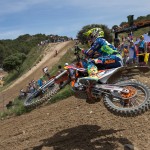Sitting in the departures lounge in Gothenburg airport after the Grand Prix of Sweden I was listening with interest as a factory-backed rider told me about the recent race in Germany two weeks before. This MXGP athlete had been lapping with HRC’s Evgeny Bobryshev on the slick Teutschenthal hard-pack and described how he was having to feed on the power gently while the Russian was able to come alongside, whack open the throttle, find traction and take off. It is common knowledge that Honda has some of the best and most advanced resources for development and racing in the paddock. The team are friendly and welcoming but the staff understandably button-up when it comes to the technical nature of their work, and the presence of almost half a dozen Japanese who have flown from the other side of the world to lend their expertise to the CRF450RW indicates there is some valuable R&D going on. We won’t really know if the ‘21’ and ‘777’ bikes are the most advanced in the MXGP field but it would be a fair guess to say there is a lot going on internally when those motorcycles are kickstarted (electric started in 2016 apparently).
Since the 450s embraced fuel injection midway through the last decade data recording and analysis have been used to monitor various performance related issues with the motor and power character set-up personalised to the rider. These boundaries at ‘the sharp end’ have expanded to encompass general aspects of the motorcycle’s behaviour and the progress of systems like GET’s ‘Power Assistance’; a loose form of traction control. The FIM blocked the use of live transmission of data and even measurement of reading telemetry outside of awnings in Grand Prix (teams used to be able to ‘plug in’ while in the pitlane) to try and slow the march of software/hardware evolution – and therefore costs – but it is now having an unquestionable influence on the state of GP bikes in both MXGP and MX2.
To try and get a handle on what is happening and why and how it can shift in the future we cornered FIM CMS President Tony Skillington, Monster Energy DRT Kawasaki’s Josh Pitts (the engineer behind Max Anstie’s Latvian GP-winning KX250F and collaboration with auto racing behemoth Cosworth), Yamaha Factory Racing Yamalube’s Fabio Santoni (responsible for Romain Febvre’s MXGP-leading YZ450F) and Rockstar Energy Suzuki World MXGP’s Roy Matheson for some more info…
Josh Pitts, Monster Energy DRT Kawasaki:
“I think manufacturers initially fitted injection onto a carburetted motor. Now the motors are much more advanced. If you look at the heads of the 450 and 250 Yamahas for example then those are fuel-injected motors. There is definitely progression and the major OEMs here have a number of people specifically directed to electronics. I would say that it is catching up now with motor racing. With MX2 all the 250s in the paddock are injected and I think the development in engines is not quite at the end of their development cycle but the next step of evolution is through injection.”
Fabio Santoni, Yamaha Factory Racing Yamalube:
“Electronics is now almost as important as chassis or suspension set-up. You need electronics for engine set-up. With depression the carburettor was almost ‘regulated’ but with this if you don’t put the correct input then it isn’t going to happen. The same with new engine parts: if you change something then it has an effect and needs to be controlled.”
Roy Matheson, Rockstar Energy Suzuki World MXGP:
“What we have found in the last few years is that we understand electronics much better for the effect they can have in this sport. We have extended our ECU parameters quite a bit, a lot more options to play with.”
Tony Skillington, FIM CMS President:
“We haven’t been keeping close enough tabs on it, to be frank and honest, and we have let it drift to the point where we are rapidly trying to catch up. We know what is going on and who-has-what but it is about damage limitation in terms of the total inclusion of electronics…which is maybe a year or two away or perhaps less. The technical commission are dealing with it because we want to contain the scene.”
To read the rest of the story in OTOR 110 click HERE








